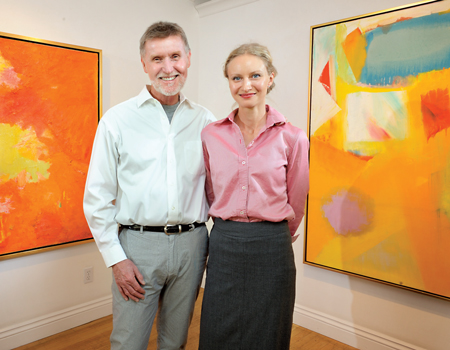The mean streets of New Jersey seem an unlikely origin for an erudite art dealer. Yet that’s where Bob Green came from, running to keep up with his father, a longshoreman and a prizefighter.
“Fighters didn’t make much in the ’30s and ’40s,” says Green, owner of Robert Green Fine Arts in Mill Valley. “He’d fight for maybe a hundred bucks and a wristwatch.”
The family moved often around the New York area, then as now a hotbed of cutting-edge art. “I was aware of the art world, but didn’t plug into it when I was a kid,” he says. Athletics hooked Green early. Lean and angular, he’s a lifelong health-and-fitness enthusiast who looks capable of long afternoons on the tennis court or ski slopes.
The art bug bit later, after college, when he was working at advertising firm Young & Rubicon in San Francisco. “A lot of compelling commercial art crossed my desk . . . many people in the ad industry are very creative, frustrated artists.”
Green’s first entrepreneurial venture grew out of his advertising experience. He and a partner assembled and sold boxed sets of art photography “that could be stuck to the wall as instant decor.” He also began buying original artwork—etchings and paintings. In 1972 he headed to Tokyo with a portfolio and hope that a Wall Street Journal article had been accurate about the Japanese appetite for Western art. “Even though I couldn’t speak Japanese, I called on dealers and found they were eager for what I had—pieces by Matisse, Miró, Paul Klee, Sam Francis and others,” he says. “I discovered that I could possibly make a living in this unusual way—traveling the world selling art.”
From Tokyo he went to Australia, where he sought gallerists and collectors in Sydney and Melbourne. Calm and mild-mannered, with just a hint of confrontational New York style, Green got on well with Australians and found them intrigued by the kind of art he offered. He connected with James Mollison, then director of Australia’s new National Gallery in Canberra, who was the center of heated controversy after spending $3 million on a huge Jackson Pollock painting, Blue Poles.
“I had two Pollock works on paper—and some psychoanalytic drawings he had done for Dr. Joe Henderson, his psychiatrist and a longtime Marin resident,” says Green. The Mollison connection led him to collectors who bought the lot. The windfall helped Green buy a house in Mill Valley. He lives with Pauline, his wife of 36 years, and their art collection in the hills above Tamalpais High School.
Throughout the ’70s and ’80s he made more than 70 trips to Australia, Asia and Europe, buying and selling art. “It was a great ride,” he says, “but I couldn’t keep traveling.” He was ready to open a gallery of his own. He rejected the city in favor of his hometown, where he could “stumble out of bed and roll in to work in a few minutes.” Robert Green Fine Arts opened in 1990, showing works by Francis, Walt Kuhlman, Robert McChesney, George Stillman and others associated with the California School of Fine Arts, as the San Francisco Art Institute was originally known.
Green and business partner Charlotte Bernstrom, pictured at left, who comes from an extensive fine art background, favor abstract expressionists and “action painters,” so called because of their bold athletic strokes on large canvases. With a sweeping gesture indicating his gallery, Green says, “What moves me is the passionate attempt to convey feelings and emotions through form and color.”
Figurative work appears rarely at Green’s gallery. Objective reality is implied only in former architect James Shay’s muted abstracts, based on coastal landforms. Featured sculptor Bill Barrett’s organic shapes suggest Keith Haring’s exuberant human forms without Haring’s literalism.
Green’s roster doesn’t include artists from the nihilistic, angst-ridden postwar school. There are no dark, brooding “slash-and-dash” paintings in his space. Instead, he prefers joyous, uplifting art—intense watercolors by Paul Jenkins, still as vibrant today as they were decades ago; riveting creations by John Grillo, a pioneer of action painting; monotypes by Francis, among the most prolific artists of the 20th century; finely wrought paintings by Mary Jones; autobiographical pieces by Chris Gwaltney; and technically astounding works by Ed Moses, in his 80s but still in his creative prime.
Green describes his gallery as “an incredibly focused body of work.” He explains further: “Artists make art to express themselves in ways they can’t verbalize adequately. They create a language of form and color.”
Mill Valley’s changing commercial environment concerns him. “This town was a significant art destination when Artisans was on Blithedale and Susan Cummins Gallery was around the corner,” he says.
Green’s 40 years of experience have bestowed a depth of knowledge and empathy that beguiles art lovers both local and far-flung. And the Marin art scene remains robust, he says. “There’s never been a shortage of talent or interest in this county.”


